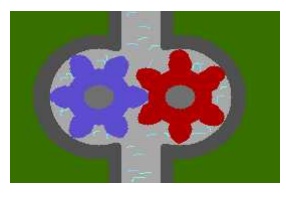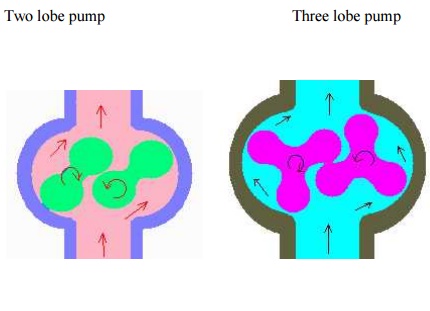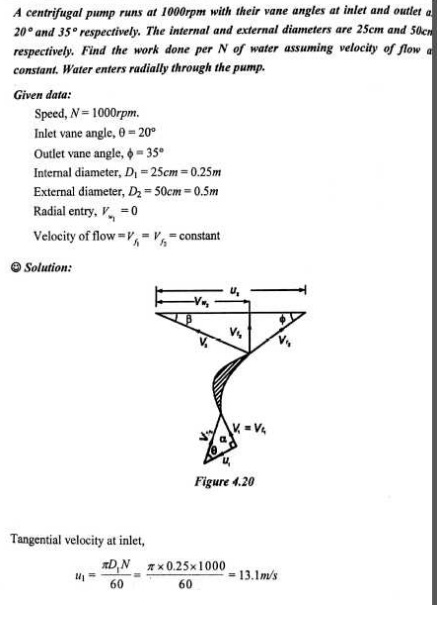Chapter: Mechanical : Fluid Mechanics And Machinery : Pumps
Pumps - Mechanics
PUMPS
PRE REQUEST DISCUSSION
Basic concepts of rot dynamic
machines, velocity triangles for radial flow and axial flow machines,
centrifugal pumps, turbines and Positive displacement pumps and rotary pumps
its performance curves are discussed in this page.
The liquids used in the chemical
industries differ considerably in physical and chemical properties. And it has
been necessary to develop a wide variety of pumping equipment.
The two main forms are the positive displacement type
and centrifugal pumps.
the former, the volume of liquid
delivered is directly related to the displacement of the piston and therefore
increases directly with speed and is not appreciably influenced by the
pressure. In this group are the reciprocating piston pump and the rotary
gear pump, both of which are commonly used for delivery against high
pressures and where nearly constant delivery rates are required.
The centrifugal type depends on
giving the liquid a high kinetic energy which is then converted as efficiently
as possible into pressure energy.
HEAD AND EFFICIANCES
1. Gross
head
2. Effective
or Net head
3. Water and
Bucket power
4. Hydraulic
efficiency
5. Mechanical
efficiency
6. Volume
efficiency
7. Overall
efficiency
Concepts
A pump is a device which converts
the mechanical energy supplied into hydraulic energy by lifting water to higher
levels.
CENTRIFUGAL PUMP
Working principle
If the mechanical energy is
converted into pressure energy by means of centrifugal force acting
on the fluid, the hydraulic
machine is called centrifugal pump. The centrifugal pump acts as a reversed of
an inward radial flow reaction turbine
Performance Characteristics of Pumps
The fluid quantities involved in
all hydraulic machines are the flow rate (Q) and the head (H), whereas the
mechanical quantities associated with the machine itself are the power (P),
speed (N), size (D) and efficiency (h ).
Although they are of equal importance, the emphasis placed on certain of these
quantities is different for different pumps. The output of a pump running at a
given speed is the flow rate delivered by it and the head developed. Thus, a
plot of head and flow rate at a given speed forms the fundamental performance
characteristic of a pump. In order to achieve this performance, a power input
is required which involves efficiency of energy transfer. Thus, it is useful to
plot also the power P and the efficiency h against
Q.
Over all efficiency of a pump (h ) = Fluid power output / Power input to the shaft = rgHQ / P
Type number or Specific speed of pump, nS = NQ1/2
/ (gH)3/4 (it is a dimensionless number)
Centrifugal pump Performance
In the volute of the centrifugal
pump, the cross section of the liquid path is greater than in the impeller, and
in an ideal frictionless pump the drop from the velocity V to the lower
velocity is converted according to Bernoulli's equation, to an increased
pressure. This is the source of the discharge pressure of a centrifugal pump.
If the
speed of the impeller is increased from N1 to N2 rpm, the
flow rate will increase from Q1 to Q2 as per the given
formula:

The head
developed(H) will be proportional to the square of the quantity discharged, so
that

The power
consumed(W) will be the product of H and Q, and, therefore

These relationships, however,
form only the roughest guide to the performance of centrifugal pumps.
Characteristic curves
Pump action and the performance
of a pump are defined interms of their characteristic curves. These
curves correlate the capacity of the pump in unit volume per unit time
versus discharge or differential pressures. These curves usually supplied by
pump manufacturers are for water only.
These curves usually shows the following relationships (for centrifugal
pump).
·
A plot of capacity versus differential head. The
differential head is the difference in pressure between the suction and
discharge.
·
The pump efficiency as a percentage versus
capacity.
·
The break horsepower of the pump versus capacity.
The net
poisitive head required by the pump versus capacity. The required NPSH for the
pump is a characteristic determined by the manufacturer.
Centrifugal pumps are usually
rated on the basis of head and capacity at the point of maximum efficiency.
RECIPROCATING PUMPS
Working principle
If the mechanical energy is
converted into hydraulic energy (or pressure energy) by sucking the liquid into
a cylinder in which a piston is reciprocating (moving backwards and forwards),
which exerts the thrust on the liquid and increases its hydraulic energy
(pressure energy), the pump is known as reciprocating pump
Main
ports of a reciprocating pump
1.A cylinder with a piston, piston rod, connecting rod and a
crank,
2. Suction pipe
3.Delivery pipe,
4. Suction valve
and
5.Delivery valve.
Slip of Reciprocating Pump
Slip of a reciprocating pump is
defined as the difference between the theoretical discharge and the actual
discharge of the pump.
Characteristic Curves Of Reciprocatring Pumps
1.According to the water being on contact with one side or
both sides of the piston
(i.)
Single acting pump (ii.)
Double-acting pump
2.According to the number of cylinders provided
(i.) Single acting pump (ii.)
Double-acting pump (iii.)
Triple-acting pump
Reciprocating pumps Vs centrifugal pumps
The advantages of reciprocating
pumps in general over centrifugal pumps may be summarized as follows:
1. They can
be designed for higher heads than centrifugal pumps.
2. They are
not subject to air binding, and the suction may be under a pressure less than
atmospheric without necessitating special devices for priming.
3. They are
more flexible in operation than centrifugal pumps.
4. They
operate at nearly constant efficiency over a wide range of flow rates.
The advantages of centrifugal pumps over reciprocating pumps
are:
1. The
simplest centrifugal pumps are cheaper than the simplest reciprocating pumps.
2. Centrifugal
pumps deliver liquid at uniform pressure without shocks or pulsations.
3. They can be directly c onnected to motor derive without the
use of gea rs or belts.
4. Valves in the discharg e line may be completely closed without
injurin g them.
5. They can handle liquid s with large amounts of solids in
suspension.
Rotary
Pumps
The rotary pump is g ood for
handling viscous liquids, nut because of the close tolerances needed, it can
not be manufactured large enough to compete with centrifugal pumps for coping
with very high flow rates.
Rotary pumps are available in a
variety of configurations. • Double lobe pump
• Trible lobe pumps
• Gear pump
• Gear Pumps
• Spur Gear or Extern al-gear pump

External-gear pump (called as
gear pump) consists essen tially of two intermeshing gears which are identical
and which are surrounded by a closely fitting casing. One of the gears is
driven directly by the prime mover while the other is allowed to rotate freel
y. The fluid enters the spaces between the teeth and the casing and moves with
the tee th along the outer periphery until it reaches the outlet where it is
expelled from the pu mp.
External-gear p umps are used for
flow rates up to about 400 m3/hr working against pressures as high
as 170 atm. The volumetric efficiency of gear pumps is in the order of 96 percen
t at pressures of about 40 atm but decreases a s the pressure rises.
Internal-gear Pump

The above figure shows the operation of a internal
gear pump. In the internal-gear pump a spur gear, or pinion, meshes with a ring
gear with internal teeth. Both gears are inside the casing. The ring gear is
coaxial with the inside of the casing, but the pinion, which is externally
driven, is mounted eccentrically with respect to the center of the casing. A
stationary metal crescent fills the space between the two gears. Liquid is
carried from inlet to discharge by both gears, in the spaces between the gear
teeth and the crescent.
Lobe pumps
In principle the lobe pump is
similar to the external gear pump; liquid flows into the region created as the
counter-rotating lobes unmesh. Displacement volumes are formed between the
surfaces of each lobe and the casing, and the liquid is displaced by meshing of
the lobes. Relatively large displacement volumes enable large solids
(nonabrasive) to be handled. They also tend to keep liquid velocities and shear
low, making the pump type suitable for high viscosity, shear-sensitive liquids.
Two lobe pump Three lobe pump

The choice of two or three lobe
rotors depends upon solids size, liquid viscosity, and tolerance of flow
pulsation. Two lobe handles larger solids and high viscosity but pulsates more.
Larger lobe pumps cost 4-5 times a centrifugal pump of equal flow and head.
Selection of Pumps
The following factors influence the choice of pump for a
particular operation:
1. The
quantity of liquid to be handled: This primarily affects the size
of the pump and determines whether it is desirable to use a number of
pumps in parallel.
2. The head
against which the liquid is to be pumped. This will be determined by the
difference in pressure, the vertical height of the downstream and upstream
reservoirs and by the frictional losses which occur in the delivery line. The
suitability of a centrifugal pump and the number of stages required will
largely be determined by this factor.
3. The
nature of the liquid to be pumped. For a given throughput, the
viscosity largely determines the frictional losses and hence the power
required. The corrosive nature will determine the material of construction both
for the pump and the packing. With suspensions, the clearance in the pump must
be large compared with the size of the particles.
4. The
nature of power supply. If the pump is to be driven by an electric
motor or internal combustion engine, a high-speed centrifugal or rotary
pump will be preferred as it can be coupled directly to the motor.
5. If the
pump is used only intermittently, corrosion troubles are more
likely than with continuous working.
Applications
The handling of liquids which are
particularly corrosive or contain abrasive solids in suspension, compressed air
is used as the motive force instead of a mechanical pump.













Related Topics